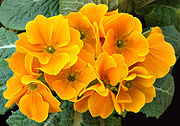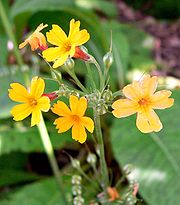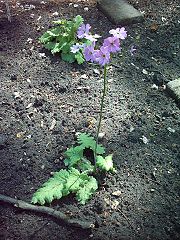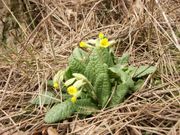
Primula
Encyclopedia






Genus
In biology, a genus is a low-level taxonomic rank used in the biological classification of living and fossil organisms, which is an example of definition by genus and differentia...
of 400–500 species
Species
In biology, a species is one of the basic units of biological classification and a taxonomic rank. A species is often defined as a group of organisms capable of interbreeding and producing fertile offspring. While in many cases this definition is adequate, more precise or differing measures are...
of low-growing herbs in the family Primulaceae
Primulaceae
Primulaceae is a family of flowering plants with about 24 genera, including some favorite garden plants and wildflowers. It is also known as the primrose family.- Genera :...
. They include primrose
Primula vulgaris
Primula vulgaris is a species of Primula native to western and southern Europe , northwest Africa , and southwest Asia...
, auricula
Primula auricula
Primula auricula, often known as Auricula, mountain cowslip or bear's ear , is a species of primrose that grows on basic rocks in the mountain ranges of central Europe, including the western Alps, Jura, the Vosges, the Black Forest and the Tatra mountains...
, cowslip
Primula veris
Primula veris is a flowering plant in the genus Primula. The species is found throughout most of temperate Europe and Asia, and although absent from more northerly areas including much of northwest Scotland, it reappears in northernmost Sutherland and Orkney.-Names:The common name cowslip derives...
and oxlip
Primula elatior
Primula elatior, the oxlip , is a flowering plant in the genus Primula, found in nutrient- and calcium-rich damp woods and meadows throughout Europe with northern bordes in Denmark and southern parts of Sweden, eastwards to Altai Mountains and on the Kola Peninsula in Russia...
. Many species are grown for their ornamental flower
Flower
A flower, sometimes known as a bloom or blossom, is the reproductive structure found in flowering plants . The biological function of a flower is to effect reproduction, usually by providing a mechanism for the union of sperm with eggs...
s. They are native to the temperate Northern Hemisphere
Northern Hemisphere
The Northern Hemisphere is the half of a planet that is north of its equator—the word hemisphere literally means “half sphere”. It is also that half of the celestial sphere north of the celestial equator...
, south into tropical mountain
Mountain
Image:Himalaya_annotated.jpg|thumb|right|The Himalayan mountain range with Mount Everestrect 58 14 160 49 Chomo Lonzorect 200 28 335 52 Makalurect 378 24 566 45 Mount Everestrect 188 581 920 656 Tibetan Plateaurect 250 406 340 427 Rong River...
s in Ethiopia
Ethiopia
Ethiopia , officially known as the Federal Democratic Republic of Ethiopia, is a country located in the Horn of Africa. It is the second-most populous nation in Africa, with over 82 million inhabitants, and the tenth-largest by area, occupying 1,100,000 km2...
, Indonesia
Indonesia
Indonesia , officially the Republic of Indonesia , is a country in Southeast Asia and Oceania. Indonesia is an archipelago comprising approximately 13,000 islands. It has 33 provinces with over 238 million people, and is the world's fourth most populous country. Indonesia is a republic, with an...
and New Guinea
New Guinea
New Guinea is the world's second largest island, after Greenland, covering a land area of 786,000 km2. Located in the southwest Pacific Ocean, it lies geographically to the east of the Malay Archipelago, with which it is sometimes included as part of a greater Indo-Australian Archipelago...
, and in temperate southern South America
South America
South America is a continent situated in the Western Hemisphere, mostly in the Southern Hemisphere, with a relatively small portion in the Northern Hemisphere. The continent is also considered a subcontinent of the Americas. It is bordered on the west by the Pacific Ocean and on the north and east...
.
Perennial primulas bloom mostly during the spring
Spring (season)
Spring is one of the four temperate seasons, the transition period between winter and summer. Spring and "springtime" refer to the season, and broadly to ideas of rebirth, renewal and regrowth. The specific definition of the exact timing of "spring" varies according to local climate, cultures and...
; their flowers can be purple
Purple
Purple is a range of hues of color occurring between red and blue, and is classified as a secondary color as the colors are required to create the shade....
, yellow
Yellow
Yellow is the color evoked by light that stimulates both the L and M cone cells of the retina about equally, with no significant stimulation of the S cone cells. Light with a wavelength of 570–590 nm is yellow, as is light with a suitable mixture of red and green...
, red
Red
Red is any of a number of similar colors evoked by light consisting predominantly of the longest wavelengths of light discernible by the human eye, in the wavelength range of roughly 630–740 nm. Longer wavelengths than this are called infrared , and cannot be seen by the naked eye...
, pink
Pink
Pink is a mixture of red and white. Commonly used for Valentine's Day and Easter, pink is sometimes referred to as "the color of love." The use of the word for the color known today as pink was first recorded in the late 17th century....
, or white
White
White is a color, the perception of which is evoked by light that stimulates all three types of color sensitive cone cells in the human eye in nearly equal amounts and with high brightness compared to the surroundings. A white visual stimulation will be void of hue and grayness.White light can be...
. Generally, they prefer filtered sun
Sun
The Sun is the star at the center of the Solar System. It is almost perfectly spherical and consists of hot plasma interwoven with magnetic fields...
light
Light
Light or visible light is electromagnetic radiation that is visible to the human eye, and is responsible for the sense of sight. Visible light has wavelength in a range from about 380 nanometres to about 740 nm, with a frequency range of about 405 THz to 790 THz...
. Many species are adapted to alpine climate
Alpine climate
Alpine climate is the average weather for a region above the tree line. This climate is also referred to as mountain climate or highland climate....
s.
The word primula is the Latin
Latin
Latin is an Italic language originally spoken in Latium and Ancient Rome. It, along with most European languages, is a descendant of the ancient Proto-Indo-European language. Although it is considered a dead language, a number of scholars and members of the Christian clergy speak it fluently, and...
feminine diminutive
Diminutive
In language structure, a diminutive, or diminutive form , is a formation of a word used to convey a slight degree of the root meaning, smallness of the object or quality named, encapsulation, intimacy, or endearment...
of primus, meaning first (prime), applied to flowers that are among the first to open in spring.
Primroses are used as food plants by the larva
Larva
A larva is a distinct juvenile form many animals undergo before metamorphosis into adults. Animals with indirect development such as insects, amphibians, or cnidarians typically have a larval phase of their life cycle...
e (caterpillar
Caterpillar
Caterpillars are the larval form of members of the order Lepidoptera . They are mostly herbivorous in food habit, although some species are insectivorous. Caterpillars are voracious feeders and many of them are considered to be pests in agriculture...
s) of some Lepidoptera
Lepidoptera
Lepidoptera is a large order of insects that includes moths and butterflies . It is one of the most widespread and widely recognizable insect orders in the world, encompassing moths and the three superfamilies of butterflies, skipper butterflies, and moth-butterflies...
species, including Duke of Burgundy butterfly
Hamearis lucina
Hamearis lucina, known as the Duke of Burgundy, is a European butterfly in the family Riodinidae. For many years, it was known as the "Duke of Burgundy Fritillary", because of the adult's similar markings to "true" fritillaries of the family Nymphalidae.-Description:The male has a wingspan of , and...
, Large Yellow Underwing
Large Yellow Underwing
The Large Yellow Underwing is a moth, the type species for the family Noctuidae. It is an abundant species throughout Europe, one of the most common and most familiar moths of the region. In some years the species is highly migratory with large numbers appearing suddenly in marginal parts of the...
, Lesser Broad-bordered Yellow Underwing
Lesser Broad-bordered Yellow Underwing
The Lesser Broad-bordered Yellow Underwing is a moth of the family Noctuidae. It is distributed throughout southern and central Europe, and southern Sweden....
, Setaceous Hebrew Character
Setaceous Hebrew Character
The Setaceous Hebrew Character is a moth of the family Noctuidae. It is found in the Palearctic ecozone. It is a common species throughout Europe. It is also found in North America, from coast to coast across Canada and the northern United States to western Alaska. It occurs in the Rocky Mountains...
and Silver-ground Carpet
Silver-ground Carpet
The Silver-ground Carpet is a moth of the family Geometridae. It is common throughout the Palearctic region, the Near East and North Africa....
.
Some flowering forms of (cultivated) Primula are commonly known as polyanthus (P. elatior hybrids) as opposite to primrose (P. vulgaris hybrids).
Classification
The genus DodecatheonDodecatheon
Dodecatheon is a genus of herbaceous flowering plants in the Primrose family Primulaceae. The species have basal clumps of leaves and nodding flowers that are produced at the top of tall stems that rise from where the leaves join the crown. They are commonly called Shooting Stars because of the...
originated from within Primula, so some authorities include the 14 species of Dodecatheon in Primula.
Sections of genus Primula
The classification of the genus Primula has been investigated by botanists for over a century. As Primula is both a large genus (abt. 500 species) and a diverse one, botanists have organized the species in various sub-generic groups. The most common is division into a series of thirty sections. Some of these sections (e.g. Vernales, Auricula) contain many species; others contain only one species.
|
|
|
Selected species
|
Primula lutea Primula lutea is a species of primrose that grows on basic rocks in the mountain ranges of southeastern Europe, including the southern and eastern Alps, southern Carpathians, Apennines, and the Balkans. The leaves are obovate and stalkless, with a cartilaginous edge, all growing in a basal rosette... Primula parryi Primula parryi is a herbaceous perennial native to wet areas from the subalpine zone to alpine tundra in the Rocky Mountains from Montana to Arizona and New Mexico.Flowers are magenta with yellow eyes... (Parry's Primrose) Primula scotica Primula scotica, commonly known as Scottish primrose, is a species of primrose that is endemic to the north coast of Scotland, including Caithness and Orkney. It is closely related to the Arctic species Primula stricta and Primula scandinavica.Primula scotica is easily distinguished from other... (Scottish Primrose) Primula sieboldii Primula sieboldii is a species of primrose that is endemic to East Asia.-References:* * * * Belgique Hort. 23:97, t. 6. 1873* Iwatsuki, K. et al. 1993–. Flora of Japan.* Richards, J. 2003. Primula.... Primula sinensis Primula sinensis, the Chinese primrose or 藏报春 in Chinese, is a plant species in the genus Primula.Primulin is an anthocyanin found in P. sinensis.... Primula suffrutescens Primula suffrutescens is a species of primrose known by the common name Sierra primrose.-Description:Primula suffrutescens is a subshrub growing from a sturdy anchoring rhizome. It has a matlike form with a thick, woody base covered in the dried remnants of previous seasons' herbage. The green... (Sierra[n] Primrose) Primula veris Primula veris is a flowering plant in the genus Primula. The species is found throughout most of temperate Europe and Asia, and although absent from more northerly areas including much of northwest Scotland, it reappears in northernmost Sutherland and Orkney.-Names:The common name cowslip derives... (Cowslip) Primula vulgaris Primula vulgaris is a species of Primula native to western and southern Europe , northwest Africa , and southwest Asia... (Primrose) |
Hybrids
- Primula × pubescens = Primula hirsuta × Primula auriculaPrimula auriculaPrimula auricula, often known as Auricula, mountain cowslip or bear's ear , is a species of primrose that grows on basic rocks in the mountain ranges of central Europe, including the western Alps, Jura, the Vosges, the Black Forest and the Tatra mountains...

